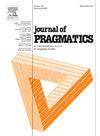Revisiting respect and politeness: Insights from metapragmatics of zunzhong in Chinese public spaces
IF 1.7
1区 文学
0 LANGUAGE & LINGUISTICS
引用次数: 0
Abstract
Respect remains a core concept in the field of linguistic politeness; however, little is known about its emic conceptualizations and evaluations in Chinese. Drawing on online public comments in response to a “seat yielding” incident, this study investigates the types of expectations underlying evaluations of zunzhong (尊重, respect) in Chinese public spaces. A metapragmatic approach is adopted, integrating both quantitative and qualitative methods. The findings reveal a shift from the traditional view of respect as deference to age and status (i.e., asymmetric respect) toward symmetric respect, grounded in expectations of equality, reciprocity, and respect-worthiness. This study highlights the situated nature of respect, providing a nuanced understanding of it among strangers or outgroup members (wairen, 外人) in public spaces. These findings have important implications for understanding the interrelationship between respect, (im)politeness, and (in)civility.
重新审视尊重与礼貌:来自中国公共空间遵忠元语用学的洞察
尊重仍然是语言礼貌领域的核心概念;然而,汉语对它的主体概念和评价却知之甚少。本研究利用网络公众对“让座”事件的评论,调查了中国公共空间中对“尊中”的评价所隐含的期望类型。采用元语用学方法,定量与定性相结合。研究结果揭示了一种转变,从传统的尊重是对年龄和地位的服从(即不对称的尊重)到对称的尊重,基于对平等、互惠和值得尊重的期望。这项研究强调了尊重的情境性,提供了对公共空间中陌生人或外群体成员(外地人,老外)之间尊重的细致理解。这些发现对于理解尊重、(非)礼貌和(非)文明之间的相互关系具有重要意义。
本文章由计算机程序翻译,如有差异,请以英文原文为准。
求助全文
约1分钟内获得全文
求助全文
来源期刊

Journal of Pragmatics
Multiple-
CiteScore
3.90
自引率
18.80%
发文量
219
期刊介绍:
Since 1977, the Journal of Pragmatics has provided a forum for bringing together a wide range of research in pragmatics, including cognitive pragmatics, corpus pragmatics, experimental pragmatics, historical pragmatics, interpersonal pragmatics, multimodal pragmatics, sociopragmatics, theoretical pragmatics and related fields. Our aim is to publish innovative pragmatic scholarship from all perspectives, which contributes to theories of how speakers produce and interpret language in different contexts drawing on attested data from a wide range of languages/cultures in different parts of the world. The Journal of Pragmatics also encourages work that uses attested language data to explore the relationship between pragmatics and neighbouring research areas such as semantics, discourse analysis, conversation analysis and ethnomethodology, interactional linguistics, sociolinguistics, linguistic anthropology, media studies, psychology, sociology, and the philosophy of language. Alongside full-length articles, discussion notes and book reviews, the journal welcomes proposals for high quality special issues in all areas of pragmatics which make a significant contribution to a topical or developing area at the cutting-edge of research.
 求助内容:
求助内容: 应助结果提醒方式:
应助结果提醒方式:


